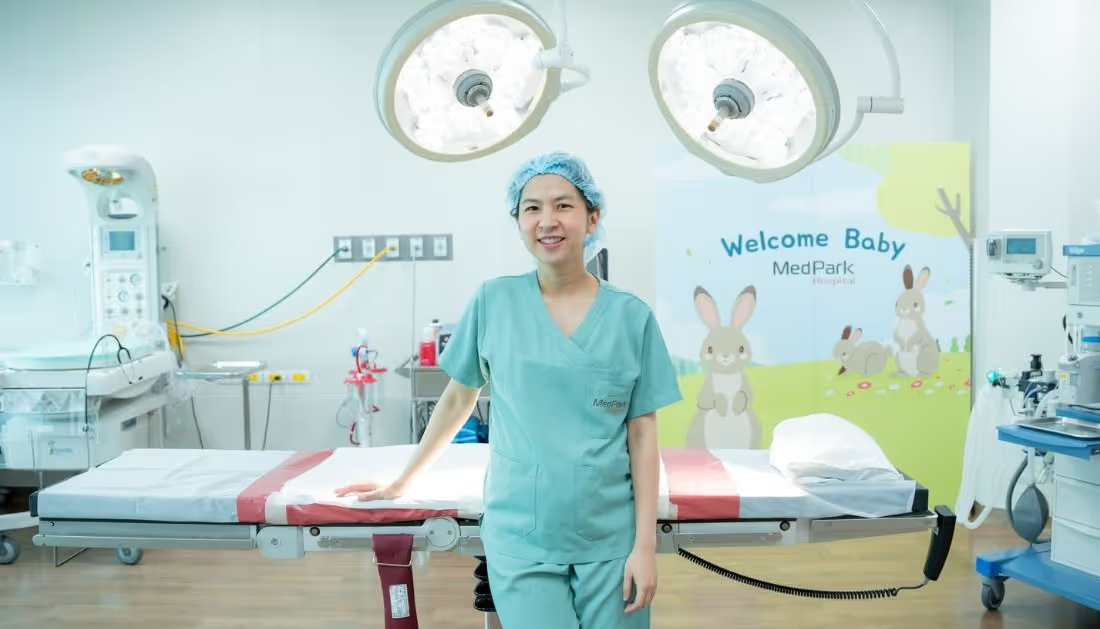In anesthesiology, our role extends far beyond simply administering anesthesia; it's about breathing life into our patients.
“We are doctors who work behind the scenes, so patients often don't know what we do. Sometimes, they only see us for 5-10 minutes before they fall asleep.”
Anesthesiologists are often misunderstood by the general public, with their crucial behind-the-scenes role in critical medical situations often overlooked. These medical professionals play a vital role in life-threatening situations, ensuring patients safely regain consciousness. Their work demands mental fortitude and extensive experience. In this article, Dr Wipra Worasawate, an anesthesiologist at MedPark Hospital, shares her career experiences to shed light on their essential contribution to healthcare.
Dr. Pang's passion for anesthesiology was kindled at first sight.
In her early years, career choices in Thailand adhered to traditional societal norms, with options primarily limited to professions like teaching, military service, law enforcement, medicine, or nursing. The absence of the internet made it hard to explore alternative career paths.
“Driven by my affinity for biology over mathematics or physics, my choices narrowed down to becoming a doctor or a dentist, not necessarily my personal preferences, but what seemed feasible.”
Her journey through medical school molded her into a determined, patient, and compassionate individual.
“In my fifth year, we rotated through anesthesiology for two weeks. What set this discipline apart was the setting of our classes – they unfolded within an actual operating room. I was captivated by the swiftness with which the administered anesthesia rendered the patient unconscious in a mere three seconds. This experience mesmerized me, prompting me to commit to diligent study throughout those two weeks, fueled by my profound interest in the subject. Surprisingly, I emerged as the top performer in the class during the subsequent exam, a departure from my usual middle-of-the-pack performance. I distinctly recall being rewarded two thousand baht for my achievement. Following my graduation and completion of my stint of service obligation under the medical student loan program, I chose to pursue a residency in anesthesiology. My unwavering fascination with the discipline made it feel like a love at first sight.”
After completing her residency, Dr. Pang blazed a trail by establishing the Department of Anesthesiology at Chulabhorn Hospital. This endeavor provided her with valuable experience, and she had the opportunity to further her knowledge through a study visit to the Memorial Sloan Kettering Cancer Center in New York, USA.
“That visit underscored the high caliber of medical technology and surgical/anesthesia techniques in Thailand, particularly for prevalent conditions like liver cancer.”
After 12 years of dedicated service as an anesthesiologist, Dr. Pang joined MedPark Hospital, bringing with her a wealth of knowledge and experience. She eagerly embraced the opportunity to contribute to the hospital's growth and success.
Is an anesthesiologist’s role limited to administering anesthesia?
"While some may hold the misconception that an anesthesiologist's role is limited to administering anesthesia, the reality is that our responsibilities extend far beyond this aspect. Our duty entails remaining with the patient throughout the entire surgical procedure. In addition to delivering anesthesia to individuals undergoing surgery, anesthesiologists are also tasked with administering anesthesia to patients in various other medical contexts, including children who require radiotherapy, undergo eye examinations, or undergo dental procedures that necessitate them to remain still. Furthermore, anesthesia or sedation becomes crucial for adult patients dealing with conditions such as confusion, cerebral artery stenosis, or dementia when they need imaging procedures like MRI or CT scans."
Anesthesiologists play a crucial role in pain management during procedures such as biopsies and prostate brachytherapy. They are also indispensable during gastroscopy, stone removal, and, notably, dental procedures. The latter presents a unique challenge, as an anesthesiologist and dentist must collaborate within the cramped space of the oral cavity. Many hospitals shun this complex undertaking.
However, Dr. Pang emphasizes that MedPark Hospital is well-equipped to support anesthesiologists working in various sites within the Hospital, ensuring a consistent standard of care outside the operating room environment. The hospital's structural design and robust infrastructure facilitate the seamless integration and utilization of necessary tools, enabling anesthesiologists to provide vital support throughout the hospital, guaranteeing safe and effective patient care.
Accepting that there are always two sides of a coin
The responsibilities of anesthesiologists are intricate and high-pressure, as they hold the critical responsibility of safeguarding patient life. Their duty extends to monitoring vital signs throughout a surgical procedure until the patient safely regains consciousness.
Anesthesiologists must attend to every facet of patient care during surgery. They induce a controlled cessation of breathing, taking on the role of breathing for the patient. Moreover, they monitor and maintain normal heart rate and body temperature; ensuring patients remain warm.
“Patients facing life-threatening conditions require surgery, as without it, their chances of survival are bleak. Nonetheless, the outcome of surgery is uncertain and does not guarantee survival. Initially, I felt overwhelmed by this reality, but I gradually adapted. Fortunately, my supervisor, co-workers, and the nursing staff provided invaluable support. It became clear that I cannot expect every outcome to be favorable, as uncontrollable factors can influence results. My perspective shifted, and I realized that my primary focus should be giving my best effort. Regardless of the eventual outcome, I must embrace and accept it.”
The ultimate reward for anesthesiologists and physicians comes when patients recover successfully and are able to return home safely. Anesthesiologists share a common objective: to ensure patients regain consciousness without complications. Hearing patients express relief, stating that the experience was less terrifying than they had imagined, is a source of deep satisfaction.
“Frequently, patients fail to recall my name since they lose consciousness shortly after encountering me. When they do remember my name or recognize that I am the individual responsible for administering anesthesia, it brings me a sense of contentment. These small gestures of recognition bring me happiness.”
Being a yoga instructor is groovy
When asked about alternative career aspirations outside of medicine, Dr. Pang didn't hesitate to mention her interest in becoming a yoga instructor. Reflecting on her past, she explained that there was limited information available about alternative professions when she was making career choices. If given the chance to turn back the clock, she still wouldn't have a clear idea of what else she might want to be.
However, if she were to leave the medical field today, she would pursue a career as a yoga instructor.
“There came a point when I desired to take better care of my body to counteract the effects of aging. Observing celebrities like Gee Acharapan engage in yoga sparked my interest in trying it myself. I acquired a membership offering unlimited classes and attended sessions frequently, driven by the fear that I might not fully utilize the membership's value. Consistent attendance gradually resulted in increased strength and a leaner physique. It has now been a decade since I started practicing yoga.”
Starting with a stiff body on her first day, she gradually learned to focus more on her body and cultivate patience. Dr. Pang discovered that yoga not only benefits physical well-being but also enhances concentration, mindfulness, and controlled breathing.
During the COVID-19 pandemic when her work as an anesthesiologist slowed down, she seized the opportunity to complete a yoga training course.
“After completing a rigorous 200-hour training program and obtaining my certification in yoga instruction, I ventured into teaching private yoga classes, discovering a genuine enjoyment in it. It felt like a new avenue of expertise I could pursue. For a moment, I entertained the idea of transitioning from being an anesthesiologist to a yoga instructor. However, as things gradually returned to normal, the hospital saw an influx of patients again, and I found myself returning to my old role.” Dr. Pang chuckled as she recounted the experience.
In addition to her yoga practice, Dr. Pang maintains a well-rounded fitness routine that includes stretching, weight training, and cardio exercises. Her foundation in yoga has significantly contributed to her overall flexibility and strength, reducing the risk of injury during other physical activities, such as running.
Dr. Pang encourages everyone to prioritize their health by engaging in regular exercise and following a balanced diet. By doing so, individuals can reduce the risk of chronic diseases like obesity and hypertension, which can complicate surgical procedures compared to individuals without these underlying health conditions.

